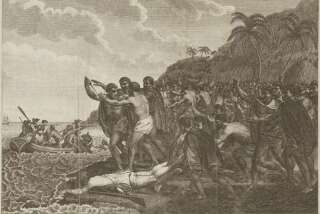The father of globalization gets his due
- Share via
In these days of rapidly expanding globalization, it’s getting harder to travel with the sense of discovery that comes from going places nobody has been before, as explorers did in the 15th and 16th centuries.
That’s why I’m drawn to such books as “Over the Edge of the World,” by Laurence Bergreen, an account of Ferdinand Magellan’s first circumnavigation of the globe, a three-year voyage that began in 1519. At the time, “more than half of the world was unexplored, unmapped and misunderstood by Europeans,” Bergreen writes. “Mariners feared they could literally sail over the edge of the world. They believed that sea monsters lurked in the briny depths, waiting to devour them. And when they crossed the equator, the ocean would boil and scald them to death.”
The book tells the gripping story of a 60,000-mile ocean voyage, marked by rough weather, hideous living conditions aboard primitive vessels, first meetings between Europeans and indigenous populations -- by turns sorrowful, violent and promiscuous -- and deaths at sea caused by scurvy or gruesome Spanish Inquisition-style torture.
Magellan was hacked to death April 27, 1521, during a confrontation with natives he incited on the island of Cebu in the Philippines. Just two of the five ships that had set out returned, one full of mutineers who turned back near the tip of South America and reached Spain before loyalists on the other vessel, spreading lies about their erstwhile captain-general.
Bergreen’s book answers the question of why anyone would volunteer for such a hazardous expedition: the lure of the Spice Islands, where a simple sailor could make his life’s fortune from a pocketful of cloves. Bergreen compares the quest for spices to today’s hunt for oil and makes readers long to see the fabled Moluccas, a handful of green, volcanic islets between present-day Borneo and New Guinea that supplied Europe’s spice racks 500 years ago.
As “Over the Edge of the World” explains, Magellan was commissioned by King Charles I of Spain to secure trading rights in the Moluccas, thereby getting a jump on Charles’ rival, King Manuel of Portugal. Discovering a way around the Americas through what is now called the Strait of Magellan, breaking the news of the massive size of the Pacific Ocean (thought at the time to be much smaller than the Atlantic) and proving incontrovertibly that the Earth is round, were in essence byproducts of the race for spice concessions.
After finishing “Over the Edge of the World,” I talked to Bergreen. He lives in New York City and is the author of books on a strikingly serendipitous range of subjects, including Al Capone, Irving Berlin and NASA’s exploration of Mars.
Question: What attracted you to the story of Magellan’s voyage?
Answer: While I was researching “Voyage to Mars: NASA’s Search for Life Beyond Earth,” scientists kept telling me about the importance of the Age of Discovery [the 15th and 16th centuries, roughly] to space exploration today. I’d also been wanting to write a sea story. Between other books, I’d go off to the library to read about [Sir Francis] Drake and [Capt. James] Cook. The process of finding the right subject was mysterious and intuitive.
Q: Why, when you finally chose Magellan, did you decide not to write his life story?
A: Biographies of him I read seemed lopsided. Little is known about his early years. Then he went off on this great voyage but died in the middle. Books tend to end there, without following the rest of the expedition.
I wanted to tell the whole story, focusing on those three years. I wanted to explain what it would have been like to have sailed with Magellan. I was astounded to find that there were enough sources to let me re-create the trip almost day by day.
Q: Where did you find them?
A: Magellan was Portuguese, but he sailed for Spain. The Archives of the Indies in Seville is the main place for primary sources on the Spanish conquests. Some are original handwritten documents, which I copied and later had translated.
Q: Was it helpful to visit Seville, the point of embarkation for Magellan’s armada?
A: I walked around Magellan’s Seville, back and forth across the Guadalquivir River and to the raffish sailors’ district of Triana. I also went to Sanlucar de Barrameda [the Atlantic port town at the Guadalquivir’s mouth]. It’s not a tourist stop, but I found it very moving. Streets there are named for Juan Sebastian Elcano [captain of the sole ship that made it around the world].
Q: Where else did you go to research the book?
A: The highlight was a 10-day trip on a small cruise ship through the Strait of Magellan in January 2000. The landscape is unbelievably somber but beautiful, dark green, moody, really out of this world. We were all silent going past, and I could imagine how awed Magellan’s men must have been. They’d never seen glaciers and were amazed to find that they are blue.
Q: The strait was named for Magellan, but in many ways he didn’t get his due. Why?
A: He was a man without a country, unpopular in Portugal and mistrusted in Spain. When the mutineers returned, they did everything they could to stain his reputation. And he didn’t make it back to promote his discoveries the way Columbus did.
Q: So why does he matter?
A: Magellan is a symbol of the spirit of exploration. He was our first global traveler. If you wanted to set a date for the beginning of globalization, it would have to be 1519, when Magellan’s ships left Spain.
More to Read
Sign up for our Book Club newsletter
Get the latest news, events and more from the Los Angeles Times Book Club, and help us get L.A. reading and talking.
You may occasionally receive promotional content from the Los Angeles Times.







